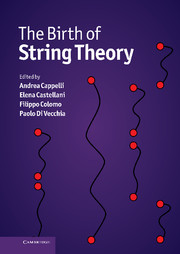Book contents
- Frontmatter
- Contents
- List of contributors
- Photographs of contributors
- Preface
- Abbreviations and acronyms
- Part I Overview
- 1 Introduction and synopsis
- 2 Rise and fall of the hadronic string
- 3 Gravity, unification, and the superstring
- 4 Early string theory as a challenging case study for philosophers
- EARLY STRING THEORY
- Part II The prehistory: the analytic S-matrix
- Part III The Dual Resonance Model
- Part IV The string
- TOWARDS MODERN STRING THEORY
- Part V Beyond the bosonic string
- Part VI The superstring
- Part VII Preparing the string renaissance
- Appendix A Theoretical tools of the Sixties
- Appendix B The Veneziano amplitude
- Appendix C From the string action to the Dual Resonance Model
- Appendix D World-sheet and target-space supersymmetry
- Appendix E The field theory limit
- Index
3 - Gravity, unification, and the superstring
from Part I - Overview
Published online by Cambridge University Press: 05 May 2012
- Frontmatter
- Contents
- List of contributors
- Photographs of contributors
- Preface
- Abbreviations and acronyms
- Part I Overview
- 1 Introduction and synopsis
- 2 Rise and fall of the hadronic string
- 3 Gravity, unification, and the superstring
- 4 Early string theory as a challenging case study for philosophers
- EARLY STRING THEORY
- Part II The prehistory: the analytic S-matrix
- Part III The Dual Resonance Model
- Part IV The string
- TOWARDS MODERN STRING THEORY
- Part V Beyond the bosonic string
- Part VI The superstring
- Part VII Preparing the string renaissance
- Appendix A Theoretical tools of the Sixties
- Appendix B The Veneziano amplitude
- Appendix C From the string action to the Dual Resonance Model
- Appendix D World-sheet and target-space supersymmetry
- Appendix E The field theory limit
- Index
Summary
Abstract
This Chapter surveys some of the highlights in the development of string theory through to the first superstring revolution in 1984. The emphasis is on topics in which the author was involved, especially the observation that critical string theories provide consistent quantum theories of gravity and the proposal to use string theory to construct a unified theory of all fundamental particles and forces.
Introduction
I am happy to have this opportunity to reminisce about the origins and development of string theory from 1962 (when I entered graduate school) through to the first superstring revolution in 1984. Some of the topics were discussed previously in three papers that were written for various special events in 2000 [Sch00a, Sch00b, Sch01]. Also, some of this material was reviewed in the 1985 reprint volumes [Sch85], as well as string theory textbooks (Green, Schwarz and Witten [GSW87] and Becker, Becker and Schwarz [BBS07]). In presenting my experiences and impressions of this period, it is inevitable that my own contributions are emphasized.
Some of the other early contributors to string theory present their recollections elsewhere in this Volume. Taken together, these contributions should convey a fairly accurate account of the origins of this remarkable subject. Since the history of science community has shown little interest in string theory, it is important to get this material on the record. There have been popular books about string theory and related topics, which serve a useful purpose, but there remains a need for a more scholarly study of the origins and history of string theory.
- Type
- Chapter
- Information
- The Birth of String Theory , pp. 37 - 62Publisher: Cambridge University PressPrint publication year: 2012



